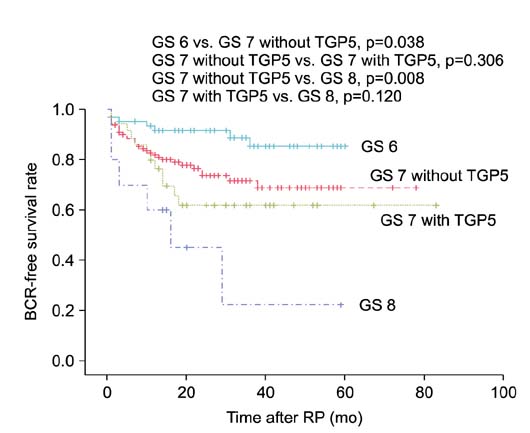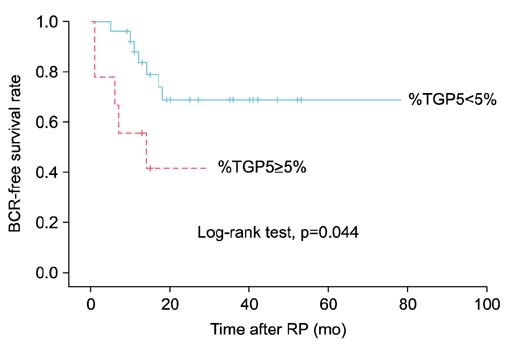Korean J Urol.
2013 Sep;54(9):587-592.
Oncologic Outcomes of Patients With Gleason Score 7 and Tertiary Gleason Pattern 5 After Radical Prostatectomy
- Affiliations
-
- 1Department of Urology, Veterans Health Service Medical Center, Seoul, Korea. uromedi94@gmail.com
Abstract
- PURPOSE
We evaluated oncologic outcomes following radical prostatectomy (RP) in patients with a Gleason score (GS) of 7 with tertiary Gleason pattern 5 (TGP5).
MATERIALS AND METHODS
We retrospectively reviewed the medical records of 310 patients who underwent RP from 2005 to 2010. Twenty-four patients who received neoadjuvant or adjuvant antiandrogen deprivation or radiation therapy were excluded. Just 239 (GS 6 to 8) of the remaining 286 patients were included in the study. Patients were classified into four groups: GS 6, GS 7 without TGP5, GS 7 with TGP5, and GS 8. We analyzed preoperative clinical factors, postoperative pathological outcomes, and biochemical recurrence (BCR).
RESULTS
TGP5 in GS 7 was an independent predictor of primary Gleason pattern 4, tumor volume larger than 10%, positive surgical margin, and lymphovascular invasion. The presence of TGP5 in GS 7 was not associated with BCR-free survival. Subgroup analyses revealed that BCR-free survival did not differ significantly between patients with GS 7 with TGP5 and those with GS 8 (p=0.120). In addition, time to BCR in patients with a higher percentage of TGP5 was shorter than that in patients with a lower percentage of TGP5. TGP5 in GS 7 was not a significant predictive factor for BCR, whereas prostate-specific antigen density and a positive surgical margin were shown to be independent predictors of BCR.
CONCLUSIONS
TGP5 in GS 7 was an independent predictor of unfavorable pathologic outcomes. The rate of BCR was similar in GS 7 disease with TGP5 and in GS 8 disease, even though TGP5 was not a significant predictive factor for BCR in Cox proportional hazards models.
Keyword
MeSH Terms
Figure
Reference
-
1. Roehl KA, Han M, Ramos CG, Antenor JA, Catalona WJ. Cancer progression and survival rates following anatomical radical retropubic prostatectomy in 3,478 consecutive patients: long-term results. J Urol. 2004; 172:910–914.2. Lim TJ, Lee JH, Lim JW, Moon SK, Jeon SH, Chang SG. Preoperative factors predictive of continence recovery after radical retropubic prostatectomy. Korean J Urol. 2012; 53:524–530.3. Uhlman MA, Sun L, Stackhouse DA, Caire AA, Polascik TJ, Robertson CN, et al. Tumor volume, tumor percentage involvement, or prostate volume: which is predictive of prostate-specific antigen recurrence? Urology. 2010; 75:460–466.4. Min SH, Park YH, Lee SB, Ku JH, Kwak C, Kim HH. Impact of prostate size on pathologic outcomes and prognosis after radical prostatectomy. Korean J Urol. 2012; 53:463–466.5. Pan CC, Potter SR, Partin AW, Epstein JI. The prognostic significance of tertiary Gleason patterns of higher grade in radical prostatectomy specimens: a proposal to modify the Gleason grading system. Am J Surg Pathol. 2000; 24:563–569.6. Epstein JI, Allsbrook WC Jr, Amin MB, Egevad LL. ISUP Grading Committee. The 2005 International Society of Urological Pathology (ISUP) Consensus Conference on Gleason Grading of Prostatic Carcinoma. Am J Surg Pathol. 2005; 29:1228–1242.7. Hattab EM, Koch MO, Eble JN, Lin H, Cheng L. Tertiary Gleason pattern 5 is a powerful predictor of biochemical relapse in patients with Gleason score 7 prostatic adenocarcinoma. J Urol. 2006; 175:1695–1699.8. Chan TY, Partin AW, Walsh PC, Epstein JI. Prognostic significance of Gleason score 3+4 versus Gleason score 4+3 tumor at radical prostatectomy. Urology. 2000; 56:823–827.9. Ro YK, Lee S, Jeong CW, Hong SK, Byun SS, Lee SE. Biochemical recurrence in Gleason score 7 prostate cancer in korean men: significance of the primary Gleason grade. Korean J Urol. 2012; 53:826–829.10. Hashine K, Yuasa A, Shinomori K, Shirato A, Ninomiya I, Teramoto N. Tertiary Gleason pattern 5 and oncological outcomes after radical prostatectomy. Jpn J Clin Oncol. 2011; 41:571–576.11. Mosse CA, Magi-Galluzzi C, Tsuzuki T, Epstein JI. The prognostic significance of tertiary Gleason pattern 5 in radical prostatectomy specimens. Am J Surg Pathol. 2004; 28:394–398.12. Sim HG, Telesca D, Culp SH, Ellis WJ, Lange PH, True LD, et al. Tertiary Gleason pattern 5 in Gleason 7 prostate cancer predicts pathological stage and biochemical recurrence. J Urol. 2008; 179:1775–1779.13. van Oort IM, Schout BM, Kiemeney LA, Hulsbergen CA, Witjes JA. Does the tertiary Gleason pattern influence the PSA progression-free interval after retropubic radical prostatectomy for organ-confined prostate cancer? Eur Urol. 2005; 48:572–576.14. Turker P, Bas E, Bozkurt S, Gunlusoy B, Sezgin A, Postacı H, et al. Presence of high grade tertiary Gleason pattern upgrades the Gleason sum score and is inversely associated with biochemical recurrence-free survival. Urol Oncol. 2013; 31:93–98.15. Isbarn H, Ahyai SA, Chun FK, Budaus L, Schlomm T, Salomon G, et al. Prevalence of a tertiary Gleason grade and its impact on adverse histopathologic parameters in a contemporary radical prostatectomy series. Eur Urol. 2009; 55:394–401.16. Whittemore DE, Hick EJ, Carter MR, Moul JW, Miranda-Sousa AJ, Sexton WJ. Significance of tertiary Gleason pattern 5 in Gleason score 7 radical prostatectomy specimens. J Urol. 2008; 179:516–522.17. Servoll E, Saeter T, Vlatkovic L, Lund T, Nesland J, Waaler G, et al. Impact of a tertiary Gleason pattern 4 or 5 on clinical failure and mortality after radical prostatectomy for clinically localised prostate cancer. BJU Int. 2012; 109:1489–1494.18. Edge SB, Compton CC. The American Joint Committee on Cancer: the 7th edition of the AJCC cancer staging manual and the future of TNM. Ann Surg Oncol. 2010; 17:1471–1474.19. Eggener SE, Scardino PT, Walsh PC, Han M, Partin AW, Trock BJ, et al. Predicting 15-year prostate cancer specific mortality after radical prostatectomy. J Urol. 2011; 185:869–875.
- Full Text Links
- Actions
-
Cited
- CITED
-
- Close
- Share
- Similar articles
-
- Use of Serum PSA in Comparison of Biopsy Gleason Score with Radical Prostatectomy Gleason Score
- The Evaluation of Concordance of the Gleason Score between Prostatectomy and Biopsies Showing more than Two Different Gleason Scores in Positive Cores
- Incidence of Pathological Downgrading and Treatment Outcome After Radical Prostatectomy in Patients With Biopsy Confirmed High Gleason Score Prostate Cancer
- The Impact of PSA on Pathologic Characteristics in the Radical Prostatectomy with PSA Level of 4-10ng/ml
- Predictors of Gleason Score Upgrading after Radical Prostatectomy in Low-Risk Prostate Cancer



